What Should a Terms and Conditions Agreement Include?
A Terms and Conditions (T&C) agreement, also called a "Terms of Use" agreement, is a document created by a company to establish guidelines and rules for its users.
It clarifies user responsibilities, the company’s rights, and clauses to protect both parties. This agreement manages customer relationships by defining limits on liability, helping prevent disputes, and setting clear expectations.
While a T&C agreement is not required by law, it’s strongly advised. Unlike Privacy Policies, which are mandated in many jurisdictions to protect user data, T&C agreements serve as a safeguard for businesses, helping to clarify rules and establish legal protections.
In this article, we’ll break down the elements needed to draft a T&C agreement, provide examples of clauses, and guide you on how to display your T&C effectively.
Definitions
The Definitions section in a T&C agreement serves to clarify important terms and remove ambiguity between the company and users.
This way, users gain a clearer understanding of rights and responsibilities as outlined in the agreement.
For example, a "User" might be anyone accessing the service, "Services" could include specific offerings, and "Account" might cover user privileges, responsibilities, and company rights over collected information.
In Mailchimp's Terms of Use agreement, it defines terms like "App" and "Campaign" to aid user comprehension:
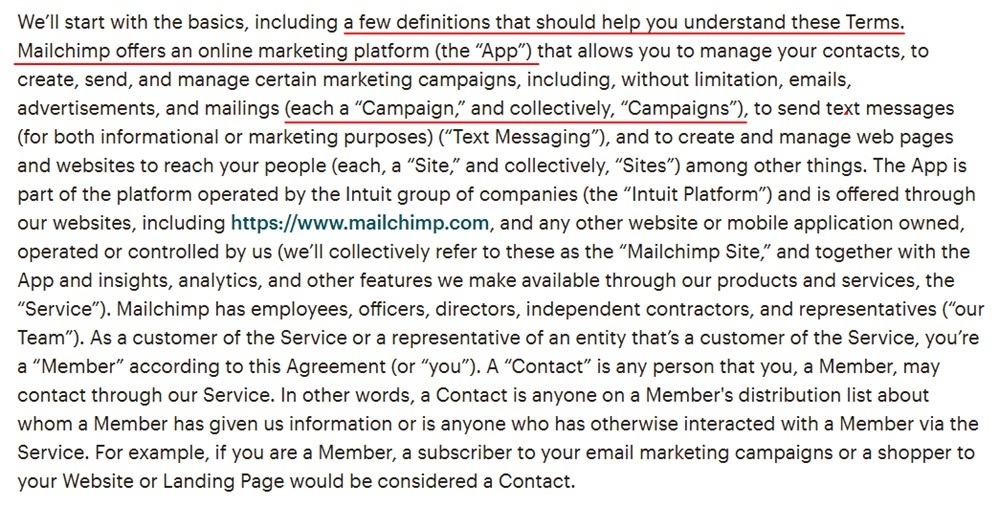
Acceptable Use Policy
Under this section, your business should establish clear boundaries for how users can interact with your platform, promoting a safe environment. List acceptable behaviors, such as:
- Accessing services for lawful purposes only
- Respecting other users’ privacy and intellectual property
- Following all community guidelines
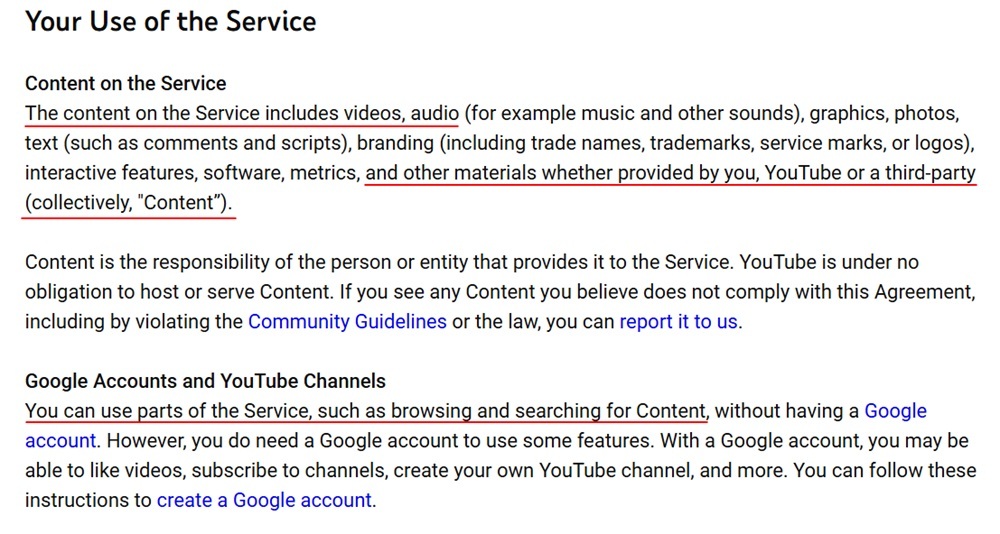
This section should also outline prohibited activities like spamming, fraud, unauthorized data access, fake account creation, and any other harmful or illegal actions. Here is an example of this section of YouTube's clause:
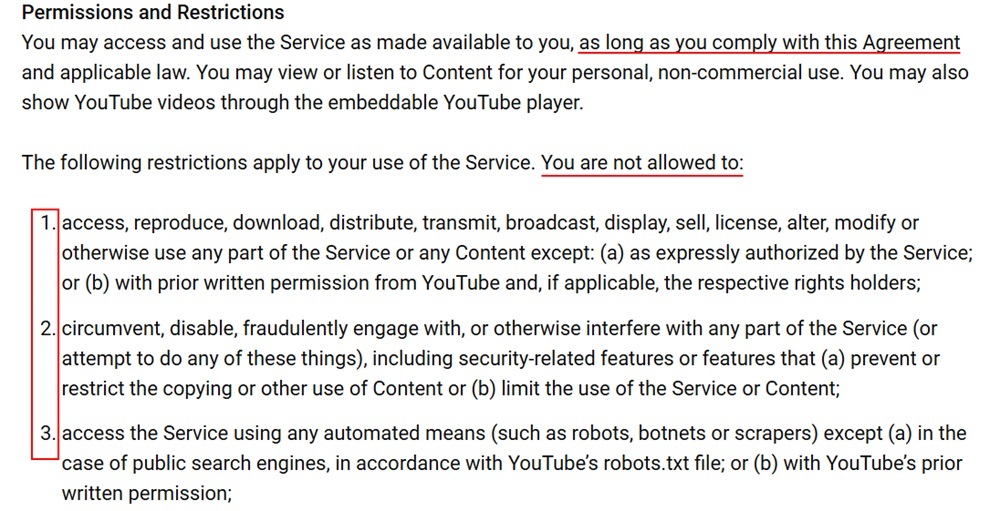
Privacy Policy Reference
In this section, briefly outline how user data might be used, such as for improving services or managing communication. Then, link directly to the full Privacy Policy, allowing users to understand how their data is collected, stored, and protected.
This approach builds trust, reassuring users that their personal information is treated responsibly and securely. Here is an example of Apple referencing its Privacy Policy in its Terms of Use agreement:

Account Termination Rights
The Account Termination Rights section details your company's right to suspend or terminate user accounts under specific conditions, supporting a secure and respectful environment. Below are some examples of reasons you should list to justify an account termination:
- Repeated policy violations, like spam or fraud
- Engaging in illegal activities or unauthorized access
- Hacking or other misuse of the platform
You should state that violations can result in immediate suspension or permanent account termination, along with possible data deletion. Legal repercussions may also apply if terms are breached. This transparency reinforces the importance of following the platform's rules.
Roblox outlines reasons for termination in its Terms of Use agreement:
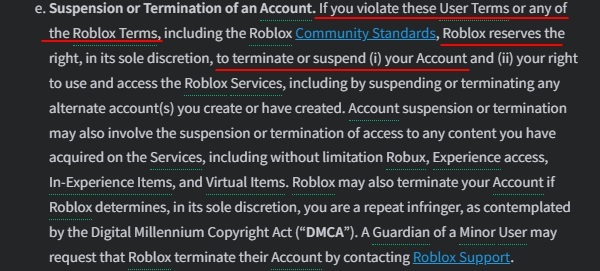
In addition, Roblox also outlines an appeal process, allowing users to request reactivation or clarify termination reasons:

This section can also include users' right to terminate their accounts, with instructions on how they can do so, as shown in this example of LinkedIn's User Agreement:
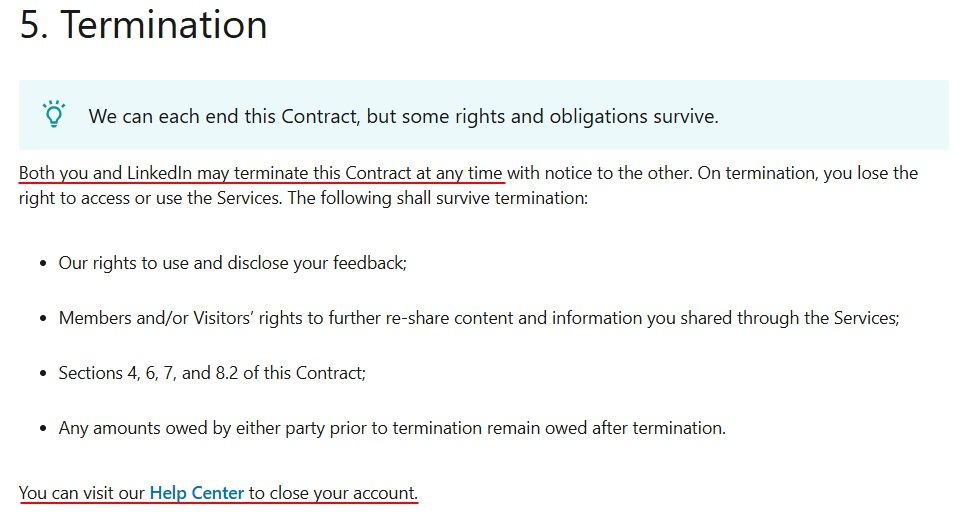
Limitation of Liability
This section clarifies that your company is not responsible for issues beyond its control, like service interruptions or unforeseen losses. It sets boundaries on liability, protecting the business from user claims when problems arise, such as system downtime or software bugs, and shows users where company responsibilities end.
Here's what you can include:
- Scope: List damages the company won’t cover, such as missed business opportunities or profits.
- Service Disclaimers: State that uninterrupted access isn’t guaranteed and outline possible issues, such as technical issues or server failures.
- Legal Remedies: Specify that users may receive limited legal remedies, like service credits, as opposed to compensation.
Pinterest lists the scope and limitations on legal remedies in its Terms of Service agreement:

Governing Law
The Governing Law clause specifies the local, state, or national laws that govern the T&C agreement. This clause sets clear legal expectations, as it identifies which jurisdiction's laws will apply in the event of a dispute.
For instance, you might state, "This agreement is governed by the laws of the State of California." If the company operates in multiple locations, designate a primary jurisdiction and consider explaining why that location was chosen (e.g., proximity to headquarters) to provide additional clarity for users.
Google outlines Santa Clara County, California, USA as the governing jurisdiction for its Terms of Service:
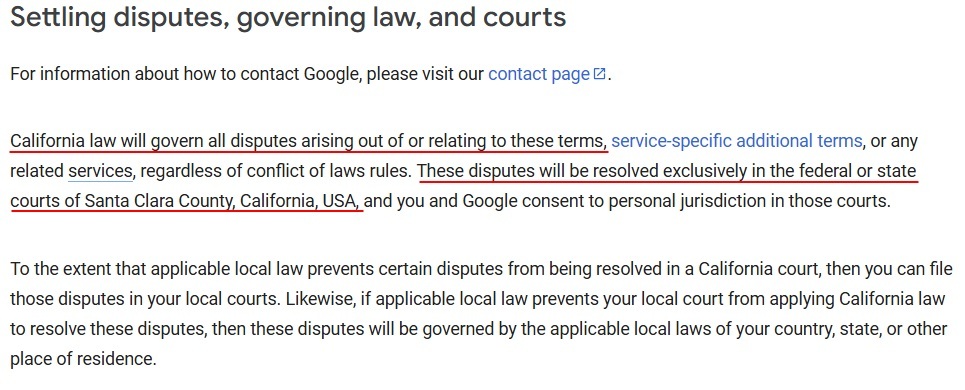
Dispute Resolution
The Dispute Resolution Clause explains how conflicts between a user and your company will be managed, often preferring out-of-court options like arbitration or mediation.
- Arbitration: In this approach, a neutral third party examines evidence from each side and reaches a decision. For example, if a customer disputes a streaming service charge, both parties may present their cases to an arbitrator, who decides if the fee was fairly applied. Specify if this decision is binding, meaning it can't be contested in court.
- Mediation: Mediation allows both sides to negotiate a solution with the assistance of a mediator. For instance, if a user claims they received a faulty product, they might meet with a mediator to agree on a resolution. Since mediation is non-binding, parties can continue discussions afterward if needed.
Etsy specifies that disputes should be resolved via binding individual arbitration:

Intellectual Property Rights
The Intellectual Property (IP) Rights section specifies your company's ownership of brand assets like logos, content, software, and designs. This clause protects against unauthorized use, preserving brand integrity and preventing copyright infringement.
Here is an example of an IP clause from Canva's Terms of Use agreement:

It should also detail permissible user actions, such as sharing links, while restricting modification or distribution of protected materials. Include consequences for IP violations, like account termination or legal action.
Additionally, clarify user ownership of user-generated content (e.g., photos, posts, and comments), confirming users retain rights. If applicable, such as on a social media platform, specify that your company has a limited license to use or display this content without transferring ownership.
For example, YouTube clarifies that users retain ownership of their uploaded content, but Youtube maintains a non-exclusive license to that content:
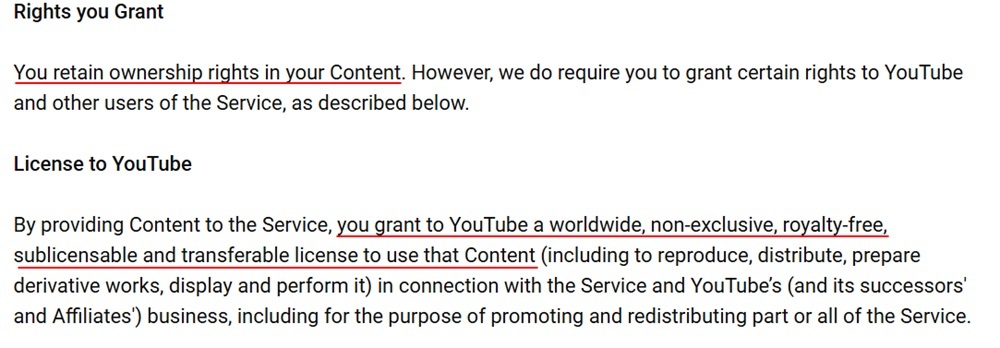
Changes to Terms
The Changes to Terms clause specifies that your company may update its T&C at any time in response to evolving business needs, platform adjustments, or legal changes. For example, you may update the T&C to include acceptable uses for a new messaging system on your platform.
By including this clause, you help users understand that the agreement may be revised periodically, encouraging them to stay informed.
To implement this section, outline how users will be notified, whether by email or a website notice, when changes are made. Clearly indicate that it is the user's responsibility to stay current on the T&C.
In addition, specify the effective date for updates. Some may take effect immediately, while others might have a future implementation date.
In the example below, The Guardian indicates that users will be notified of updates through a notice posted directly on the website, with the changes taking effect immediately:

External Links Disclaimer
To protect your business from liability linked to third-party websites, the External Links Disclaimer specifies that any content accessed through external links on your platform is beyond your responsibility.
This disclaimer reinforces that these external sites operate independently, and your business is not accountable for their content, privacy policies, or services, nor for the reliability or safety of the information they provide.
Make it clear that the presence of a link on your site does not imply endorsement or a partnership with the third-party site. To further limit liability, include details on areas explicitly waived, such as misinformation, data breaches, or issues related to transactions with third-party vendors, ensuring users understand the boundaries of your platform's responsibility.
Wikimedia specifies that it isn't responsible for the content, accuracy, or safety of external sites:

Where Should You Display Your Terms and Conditions Agreement?
To ensure visibility and accessibility, place your T&C in key locations across your website.
For instance, CNBC includes a link to its Terms of Service agreement in the footer, making it accessible from any page:

Etsy places its agreement link near the sign-in button. It states that by clicking "Sign in," users agree to its Terms of Use and Privacy Policy:
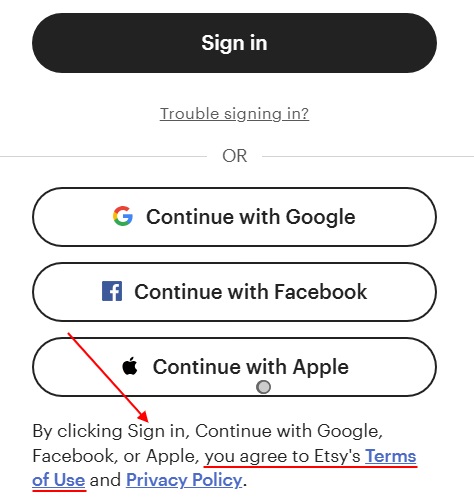
On some ecommerce sites, such as Zara, users see a link to Purchase Conditions at checkout, confirming they've reviewed and accepted the terms before finalizing the transaction:

How Do You Obtain User Consent?
Consent indicates that users acknowledge and agree to the policies in your T&C, which simplifies enforcing compliance and provides legal protection for your company.
Obtaining consent also promotes transparency, giving users a clear understanding of the terms before accessing products, services, or completing transactions. Below are common methods for collecting user consent.
"I Agree" Checkbox
Typically found during sign-up or checkout, this checkbox prompts users to confirm they have read and accepted the T&C, creating a clear record of their acknowledgment.
During sign-up, Metricool links to its Legal Terms with a required checkbox for users to acknowledge they've read and agree to it:
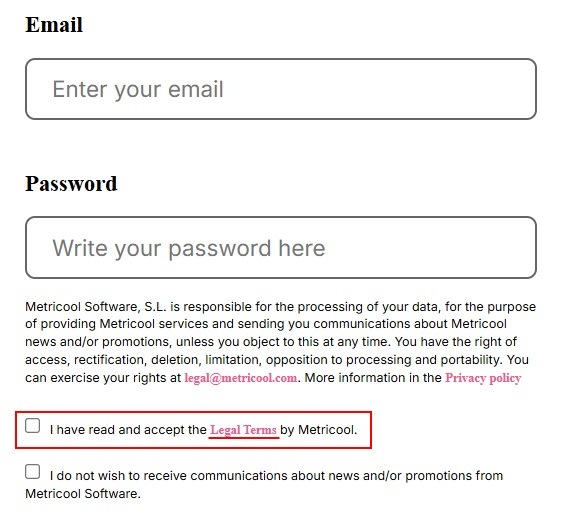
LinkedIn requires users to click "Agree & Join" to move forward with the sign-up process:
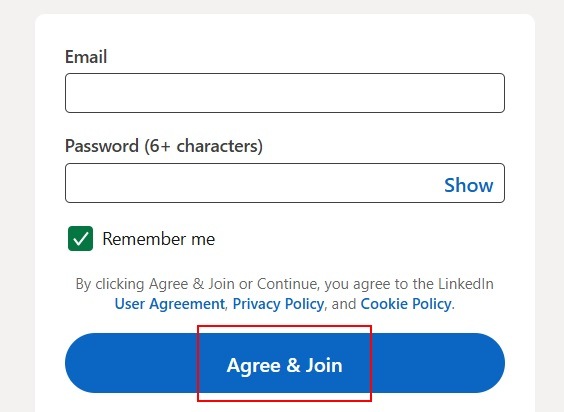
Summary
A well-constructed Terms and Conditions (T&C) agreement provides clear guidelines and protections for both the business and its users. Key elements include:
- Definitions: Clarify terms to ensure understanding of roles and responsibilities.
- Acceptable Use Policy: Outline allowed and prohibited behaviors to promote a safe environment.
- Privacy Policy Reference: Link to data usage details for transparency.
- Account Termination: Specify conditions for suspending or terminating accounts.
- Limitation of Liability: Define liability boundaries to manage user expectations.
- Governing Law: State which jurisdiction’s laws apply in disputes.
- Dispute Resolution: Detail options like arbitration or mediation for handling conflicts.
- Intellectual Property: Protect brand assets and clarify user rights.
- Changes to Terms: Retain the right to modify terms when necessary.
- External Links Disclaimer: Limit liability for third-party content.
Displaying the T&C prominently and obtaining clear user consent helps reinforce compliance and transparency.